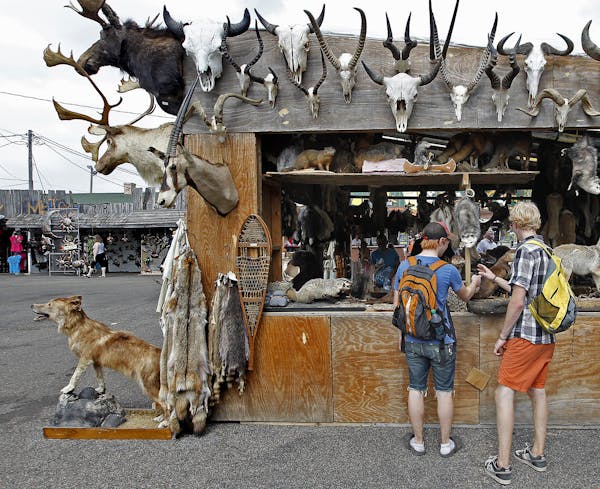Heritage Square at the Minnesota State Fairgrounds is no more.
The old wooden fence, arched entry and weathered booths where vendors sold barbecued turkey legs and Americana-related crafts have been cleared to make way for the biggest transformation to the fairgrounds since a series of Depression-era building projects in the 1930s.
State Fair officials on Wednesday unveiled plans for a $15 million West End Market, to be built in the same area west of the grandstand with many of the same food, artisanal and craft vendors — but with new and long-overdue improvements, said Jerry Hammer, the fair's general manager.
"This project has been brewing for a long time," often taking a back seat to less visible projects such as roof repairs to the livestock buildings, Hammer said.
A 150-year-old log cabin, a windmill, the old North St Paul train depot and the Royal American Shows train cars that hold many State Fair artifacts will be displayed at or near the market, and a restored steel arch dating from 1933 will greet visitors outside, Hammer said.
The Minnesota Newspaper Foundation's museum has already been moved to its new display area in the arcade of the 4-H Building on the eastern side of the fairgrounds.
Unlike Heritage Square, which opened in 1964, the new buildings will be designed to be permanent.
The old Heritage Square "was never intended to last very long — five, six, seven years, then knock it down and build something else," Hammer said. "It was that same structure that was intended to last just a few years that we've been using now for almost 50 years."
The West End Market will be circular, with buildings arranged around a hub. Like the International Bazaar, the buildings will offer shelter but also be open to the elements, he said.
The market will include an amphitheater and, in a nod to the past, a State Fair history and heritage center. A display area called Heritage Square will be in front, "so the name will live on," Hammer said.
Construction is expected to be done in time for the fair's opening day next August.
Among the new food vendors will be Axel's Bull Bites, which will relocate from the Food Building and may include a rooftop patio overlooking the amphitheater.
A restaurant called the Blue Barn, run by the Blue Plate chain of popular neighborhood eateries, will resemble the large old barns that once dotted the rural landscape and will pay homage to rustic fare.
"It will be a little slice of Americana," said co-owner Stephanie Shimp. "Blue Plate Restaurant Company is a collection of neighborhood diners. We feel we fit into the fair because this is a neighborhood."
Also staying on will be Rosebud's Cottage, a quilting supply shop. "I have to say, our customers were very worried about us," said Roseann Kermes, who has run a fair booth for seven years along with her year-round shop in White Bear Lake.
Construction of a major transit hub will also be part of the project. The new gate will be the busiest one at the fair, Hammer said, replacing the congested parking area on the south end of the grounds along Como Avenue. More than one-third of the fair's 1.8 million visitors come through the Como gate, and buses from the fair's park-and-ride system will make their stops at the new gate.
Heritage Square began as a place on the fairgrounds geared for teenagers. It had several names — Teen Age Fair, Young America Center, and Youth Expo — before its popularity waned. It was revamped and re-christened Heritage Square in time for the bicentennial celebration in 1976.
Jim Anderson • 651-925-5039 Twitter: @StribJAnderson
Neighbors, city officials at odds over Rochester lake dam

Souhan: This is KAT's chance to prove Flip Saunders was right

The story of Hercules the cat: Rescued in 2022, Target model in 2024

Minnesota State Patrol celebrates diverse new class of troopers

